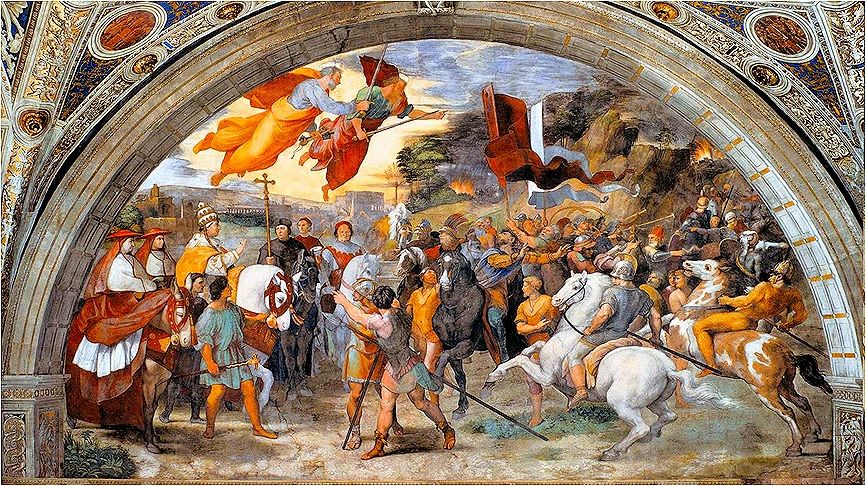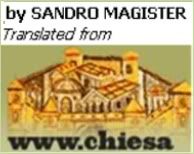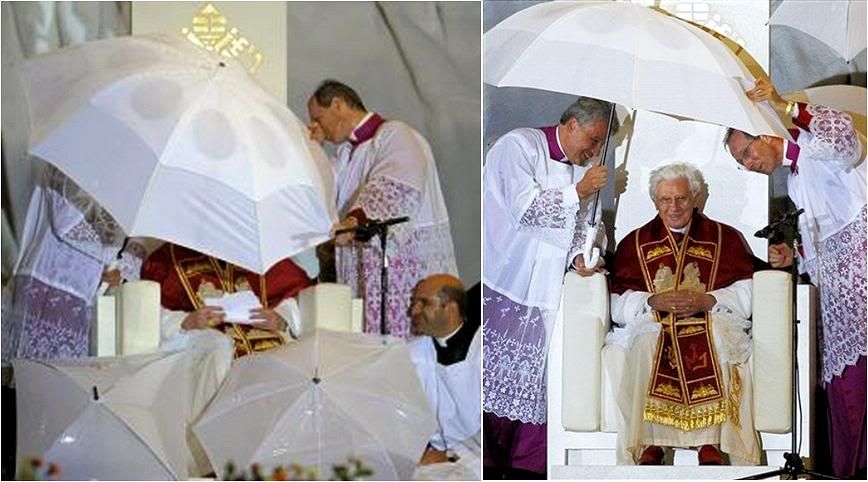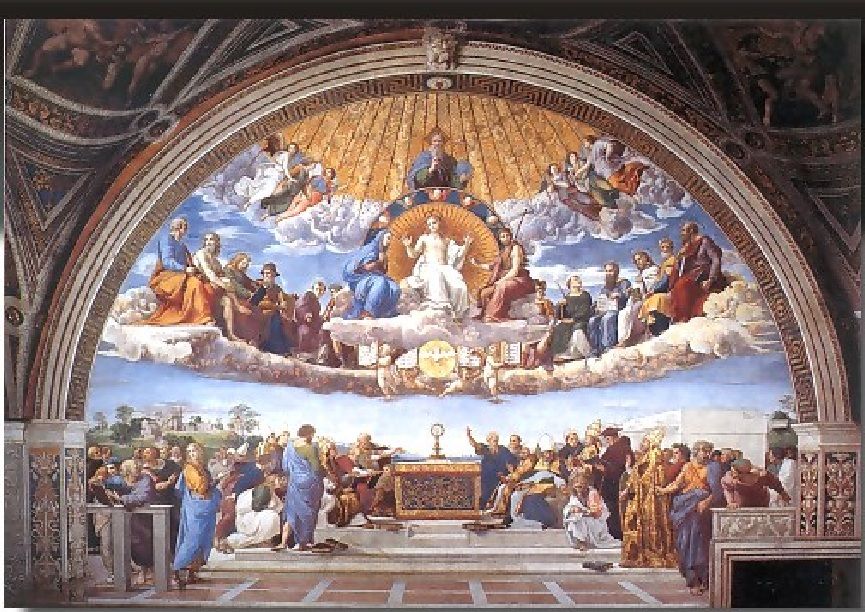 Many thanks to Beatrice and her Spanish collaborator and translator Carlota for leading me to this delightful interview. I am so pleased with the insight of this Spanish priest who gives an original perspective to the comparisons that others have already made of Benedict XVI to Leo the Great - except that the earlier comparisons were on the basis of their common greatness as preachers and teachers of the faith. This also compares them on the basis of Leo's singular act of heroism in going forth to meet Attila the Hun and turning him back from the gates of Rome.
Many thanks to Beatrice and her Spanish collaborator and translator Carlota for leading me to this delightful interview. I am so pleased with the insight of this Spanish priest who gives an original perspective to the comparisons that others have already made of Benedict XVI to Leo the Great - except that the earlier comparisons were on the basis of their common greatness as preachers and teachers of the faith. This also compares them on the basis of Leo's singular act of heroism in going forth to meet Attila the Hun and turning him back from the gates of Rome.
As much as Raphael's painting of that meeting is impressed in my mind - with the hovering figures of Peter and Paul sending Attila and his horse rearing back - it never once occurred to me to see the quite obvious contemporary analogy in Benedict XVI's stand against the barbarisms of unreason and relativism. I must learn to stand back more from the subject, Benedict, so I do not miss the forest for the trees...
 Meeting between Leo the Great and Attila, Raphael, 1514, Fresco, Standa di Eliodoro, Vatican Apostolic Palace.
Like Leo the Great, Benedict XVI
Meeting between Leo the Great and Attila, Raphael, 1514, Fresco, Standa di Eliodoro, Vatican Apostolic Palace.
Like Leo the Great, Benedict XVI
stopped the barbarians at the gate
Interview by J. MORÁN
Translated from

April 24, 2013
The former rector of the Basilica del Sagrado Corazon (Sacred Heart Basilica) in Gijon, Julián Herrojo, gave a lecture yesterday at the Ateneo Jovellanos on "Benedict XVI, assessment of a Pontificate".
Fr. Herrojo, now parish priest of the Cristo de las Cadenas church in Oviedo, highlighted the role that Benedict XVI played in society at large before he renounced the Papacy on February 29. We interviewed him about this.
How would you summarize the Benedict XVI Pontificate in short?
Benedict XVI is the Pope - if not the greatest in history because that is difficult to judge - who has been the most profound in the history of the Church, and I make a symbolic parallel between him a St. Leo the Great who kept Attila and the Huns from conquering Rome when the barbarians invaded most of Europe.
Benedict XVI likewise kept back the barbarism of irrationality that had been expanding through Europe in the past two to three decades. And that is why some works which have anthologized his teachings or commentaries about his teachings, have had titles like
Dios salve la razon (God save reason!) by Gustavo Bueno. All this attest to his most courageous stand against the barbarities of irrationality and relativism.
What was his central message?
It appears me that likewise, Benedict XVI has been the Pope that in the whole history of the Church has sought most to approach and address the world outside the Church. Obviously, a Pope's first mission is to govern the Church and look after the faithful, but without ignoring the Church's mission to evangelize the world.
In this sense, It is Benedict XVI who has most addressed the outside world to show them the value that the Christian faith can have, even for the non-believer and for the rest of the world, precisely because it rests on reason.
For example, something particularly luminous in his teaching is to insist repeatedly that the Church did not invent natural law but that she could make a philosophy out of it compatible with Christ's teaching, and that therefore, what the Church proposes to the world, to society and to states, all derive from reason, from nature, and from natural law, which everyone recognizes.
[I must confess that I have more or less taken Benedict XVI's discourses 'for granted' in the sense that he has been so consistent in everything he says, so one is not surprised, but he always finds new ways to say them, which is always an exhilarating experience. But I have never really stood aside to consider how his ideas may be received by minds that are not necessarily receptive to Christian ideas and may even be hostile to begin with. Yet what thinking mind could argue with natural law and reason as common ground we can all stand on while arguing our differences? Nor did it really occur to me what Fr. Herrojo points out that B18 was the first Pope to address himself directly to the secular world - not once but repeatedly, not in passing but in magisterial presentations, and in terms they could relate to, without taking offense at any irruption of religion into the discourse, but terms which are nevertheless part of the bedrock of Christian faith. And I thank God that there are better ways to be remembered for and celebrated than, say, refusing to live in the Apostolic Palace. My apologies, Your Holiness, who I am sure will be remembered and celebrated for much more than that!]
And was he successful?
One gets an idea of what he conveyed to the world in the words of Nobel Prize winner Mario Vargas Llosa who said, upon the announcement of Benedict XVI's renunciation, that he was the only Pope he would read with great enjoyment and satisfaction, without getting bored, and considering the fact that he, Vargas Llosa, is an agnostic.
And compared to Papa Wojtyla?
John Paul II took away our fear of proclaiming ourselves Catholics, and Benedict XVI made us proud to call ourselves Catholics and to proclaim it. He is a great figure for me, and so I was very thankful for the invitation to speak about him because I have wanted to say these things about this great Pope in public.
Which of Benedict XVI's interventions would you cite in particular?
The three which I would consider most substantial - outside of his three encyclicals - are those that I call his magisterial lectures. In chronological order, the lecture on faith and reason at the University of Regensburg, which provoked a wave of Muslim protests because of the words he quoted from a Byzantine emperor.
Then, there was the address he gave in Westminster Hall during his visit to England in 2010, in which his principal theme was the Christian presence in the public sphere and the need for an ethical basis for the State and for society. I thought it was very brilliant, as did the British media and elite who were unanimous in their praise.
And the third one, which some think was the best of all, was his address to the German Bundestag, where he spoke of Natural Law, and of the use of reason in law.
The underlying thread for all three was reason and natural law as the sources for manmade laws, the basis for coexistence in civilian society, and as the contribution of Catholics and the Church to public life.
[For some reason, Fr. Herrojo omits the address at the College des Bernardins in Paris, but perhaps because it was not strictly secular. In fact, it was about how the search for God that underlay the vocation of the medieval monks enabled them not just to save Western civilization in the Dark Ages but even to enrich it through 'ora et labora', prayer and work.]
What do you think of Pope Francis?
It's too early to say, but I am hopeful. In the past two centuries, the Church has had extraordinary figures in her Popes, and I have no doubt Francis is one. Obviously each Pope has his own style and his own contribution to the Church and to the world.
Much has been made of his simplicity and humility, reflected even in the papal name he chose, and so the mark he leaves will be along those lines. But rather than speaking of humility, I prefer to speak of his simplicity which is a means of establishing close contact. One thinks of St. Francis bringing the Gospel to the Sultan of Egypt and he did so in all simplicity.
And Papa Bergoglio compared to Papa Ratzinger?
Benedict XI is also an extraordinarily humble man - no one can ignore that. In fact, there was an article in the German newspaper Die Welt after his resignation which called him "too holy, too innocent, too pure" but still very human. He, too, when he was a cardinal in Rome, was not above traveling by bus, as Cardinal Bergoglio did in Buenos Aires. I think such gestures, rather than acts of humility, are simply signs of being natural, being simple, like normal persons are. And they are important because they condense an idea into an image. Behind every gesture that is natural and not put on, there is a way of being and the ideas that go with it. I expect much from Francis, as does the Church and the world. And I have no doubt that his election was the right thing.
How did you experience the transition from the Basilica of Gijon to the Cristo de las Cadenas in Oviedo?
They are both very different. I won't deny that it cost me much effort because I spent long and intense years in Gijon, years that I will always carry in my soul and in my memory. It was like a pain that assails you all of a sudden, without expecting it. But then it goes, and everything is back to normal. The truth is that after six months, I am settling down and happily.
In her footnotes, Carlota says Fr. Herroo is a distinguished intellectual figure in Spain, is a great Biblical scholar who lived for years in Jerusalem,, and an expert on medieval history. The Basilica in Gijon where he was rector is the contemporary successor of a cathedral that was destroyed during the Spanish civil war with the death of 340 martyrs to the faith who were imprisoned in the church and then killed.
4/27/13
P.S. I was intending to run the following as part of a three-article post in a lookback feature for today, but this article by Sandro Magister on 4/27/12 is, serendipitously, a companion piece to the above, in that Magister develops here his comparison of Benedict XVI to Leo the Great as a master homilist. (Just as serendipitously, the Magister piece is accompanied by another great Raphael fresco in the Vatican.) This article was a belated tribute to B16 on his 85th birthday/7th anniversary as Pope...


 Sandro Magister also finally filed his seventh anniversary tribute to the Pope, but I find it flawed by his failure to check a few basic facts (trusting his memory instead) and by a couple of conclusions that I respectfully disagree with.
What distinguishes Benedict XVI
Sandro Magister also finally filed his seventh anniversary tribute to the Pope, but I find it flawed by his failure to check a few basic facts (trusting his memory instead) and by a couple of conclusions that I respectfully disagree with.
What distinguishes Benedict XVI
after seven years as Pope -
He will perhaps be remembered more for his homilies than his encyclicals
And for his daring moves which are usually far from mainstream.
As in the Madrid WYD, during a sudden and violent thunderstorm...

ROME, April 27, 2012 – No one said it last week in the flood of tributes to Benedict XVI on his seventh anniversary as Pope. But the element which most revealed the profound sense of his Pontificate was a summer thunderstorm.

It was a torrid night in Madrid in August 2011. In front of Pope Benedict, on the vast esplanade of a disued airportm a nkllion and a half young people, average age 22, largely 'unknown'.
Suddenly, a torrent of rain with thunder, lightning and huge winds struck the assembly, out in the open, without refuge. Clusters of spotlights fell off their moorings, posters and other light items were blown away, and even the Pope appeared drenched
[despite the huge umbrellas his aides vainly tried to shield him with].
But he stayed where he was, to the explosive jubilation of his audience, their spirits undampened by the unexpected manifestation from the heavens.
When the wind and rain ceased, after about 20 minutes, the Pope disposed of his prepared text and spoke briefly to the soggy assembly.
[Actually, he then left the stage briefly to change into vestments for the Eucharistic Benediction and Adoration, while stage crew checked out there was no structural damage to the stage and its hangings.]

He asked them to look to Jesus, living and present in the consecrated host, the Blessed Sacrament on the altar. World Youth Day 2010: the Eucharistic Adoration.
And he knelt in worshipful silence. The cue for his congregation to kneel on the soggy ground. And so they remained in total silence. For as long as their Pope led them.
[Later, before leaving them for the night, he said the following: “Dear young people we have lived an adventure together; firm in our faith in Christ we have resisted the rain! Before I go I would like to wish you all a good night. Thank you for your joy and your resistance! Thank you for the incredible example you have given. Like this night with Christ. you can always overcome life’s trials, never forget this!” A most fitting end to an episode unprecedented in papal annals.]
This was not the first time that Benedict XVI had set the example for Eucharistic Adoration at World Youth Day. He did it at the first one he attended in Cologne in 2005, to the wonder of many.
[For the first time the world saw almost a million young people kneel in silent worship of the Eucharist, on that field in Marienfeld. And it would happen again on a racetrack outside Sydney at WYD 2008. On a smaller scale, with the Catholics of London in Hyde Park, September 2010, and with the youth of Croatia in Zagreb in 2011.]
In evaluating this Papacy, few have understood the audacity of these actions which are far from mainstream. But when Benedict XVI does them and explains why, he does so with the calmness of someone who is not inventing anything of his own, but is simply going into the depth of human adventure and Christian mystery.

Five centuries ago, Raphael, in his sublime fresco entitled "Disputation over the Blessed Sacrament' found in the Apostolic Palace, had placed the consecrated host in the center of his composition, on the altar of a grand cosmic liturgy in which the Father, the Son and the Holy Spirit interact with the earthly and cedlestial Church, in time and eternity.
When Benedict XVI convoked his first Assembly of the Bishops' Synod in 2005, he dedicated it to the Eucharist. [I don't know how Magister can make this mistake about a fact I had supposed everyone covering the religious beat would know: The Synodal Assembly was convoked the previous year by John Paul II, who decided it would be dedicated to the Eucharist. Benedict XVI did 'benefit' enormously from inheriting the Synodal Assembly, for which he then wrote that amazing Post-Synodal Apostolic Exhortation that remains one of the best texts of his Pontificate - in an embarrassment of great texts - but it is simply wrong to say he convoked it.]
It was his idea to have an image of that very fresco by Raphael projected on the wall screens in the Synod Hall for the benefit of all the bishops of the world.
A great deal of discussion ahs been generated by Benedict XVI's erudite lectures at the Unviersity of Regensburg and the College des Bernadins in Paris, at London's Westminster Hall and in the German Bundestag.
But it will be shown one day that the true distinction of this Pope are his homilies, as they had been centuries ago for Pope Leo the Great, the Pope who stopped Attila the Hun at the gates of Rome.
[Magister is probably biased by the fact that he has made it his admirable task to compile Benedict XVI's homilies and Angelus messasges throughout the liturgical year for the past three years now and will probably continue. But IMHO, Benedict XVI is distinguished by - and will be remembered long after - for more than just his homilies, but for the extraordinary richness of his writing in all genres of papal documents and secular texts. Of course, his homilies are great, and would tend to be remembered more, or quoted more, because they are brief. But how can anyone say that the text of JESUS OF MAZARETH or of Spe salvi or Sacramentum caritatis or Verbum Domini, or the Regensburg and Bernardins lectures, just off the top of my head (because they happen to be my favorite texts), are any less great and memorable???? Nor can one discount the other texts addressed primarily to the secular world, because I have not come across any Church historian pointing to any precedent or parallel text from previous Popes.]
Benedict XVI's homilies are those that attract the least notice. He says them during Mass
[or Vespers]/ Thus, perilously near
[why 'perilously?] Jesus whom he indicates to all as present in the bread and wine - the Jesus whom, as he preaches tirelessly, was the very same who had explained the Sacred Scriptures to the two disciples on the road to Emmaus, who were so similar to the disoriented men today, the Jesus who revealed himself to them when he broke the bread - as in Caravaggio's famous painting at the National Gallery in London - and who vanished from sight as soon as they recognized him. Because that is how faith is, it is never a view that is geometrically complete, but the inexorable play between freedom and grace.
To the little or no faith of so many men today, to the Masses that have been trivially reduced to peace 'embraces' and brotherly assemblies, Pope Benedict instead offers a palpable faith in the God who makes himself near to us, who loves and forgives, and who gives us himself so we may partake of his Body and Blood.
This was the faith of the early Christians, as Benedict XVI recalled in his Angelus homily two Sundays ago. The designation of Sunday as 'the Lord's Day', he said, was a gesture of revolutionary daring by the Apostles, because the event that it recalled had been so extraordinary and overwhelming: the resurrection of Jesus, as well as his subsequent appearances as the Risen Lord among his disciples, which fell on the 'first day of the week', the day God began Creation.
The earthly bread that becomes communion with God, Benedict said in another homily, "is the start of the transformation of the world - into a world of resurrection, a world of God".
Now, a further reservation about Magister's primary statement. The extraordinary fact of what took place at Cuatro Vientos in August 2011 was not that the Pope had stayed despite the near-Biblical tempest - I cannot imagine any other Pope who would not have done what he did.
The extraordinary thing was for the Eucharistic Adoration to take place as it did, for Benedict XVI to have decided not to forego the high point of the program - literally, come hell or high water - out of any misplaced 'consideration' for his congregation ("The poor dears - they're wet and cold and uncomfortable. Let's not put them through another half hour in their condition!").
He judged correctly that these hundreds of thousands who had kept him company for three days already, had not come to Madrid to be 'comfortable' but to find their faith, to show their faith, and to be proven in their faith. So, of course, they had no problem joining him in Eucharistic Adoration. That, to me, after the compelling reality of one and a half million people kneeling on the mud for Eucharistic Adoration, was the other extraordinary thing - the Pope's faith in this young people, and his confidence that his faith in them is not misplaced.
Note from the Patrons of the Vatican Museums about the Raphael fresco:
The Disputation over the Blessed Sacrament (or more appropriately, The Triumph of Religion), painted by Raphael between 1508 and 1511, represents Christianity’s victory over and the transformation of the multiple philosophical tendencies shown in the School of Athens fresco on the opposite wall. The theologians of the Disputation are not gathered in a vaulted temple like the philosophers of the School. Instead, their bodies make up the Church’s architecture. They form one body, united in an ethereal apse flanking the Trinity and the Eucharist, that when consecrated becomes the body of Christ.

 P.S. I apologize for my carelessness. I never remember to check back promptly that I have posted things right, so for several hours I had two duplicate posts on this page that I had not realized - this is not the first time it has happened - which resulted in the last two posts going on to the next page. (Each page accommodates only 20 posts, no matter how long or how short each post is). I have now removed the duplicates, and the two last posts are where they should be. Mea maxima culpa.
P.S. I apologize for my carelessness. I never remember to check back promptly that I have posted things right, so for several hours I had two duplicate posts on this page that I had not realized - this is not the first time it has happened - which resulted in the last two posts going on to the next page. (Each page accommodates only 20 posts, no matter how long or how short each post is). I have now removed the duplicates, and the two last posts are where they should be. Mea maxima culpa.
[Modificato da TERESA BENEDETTA 27/04/2013 14:47]